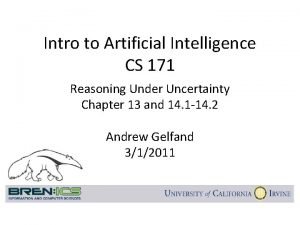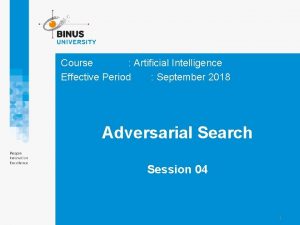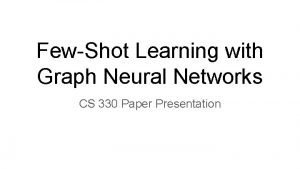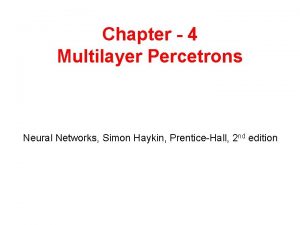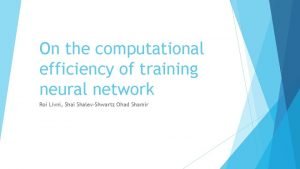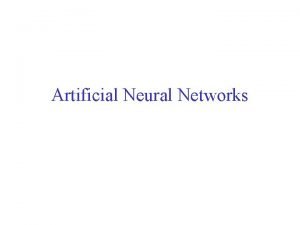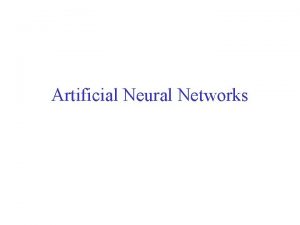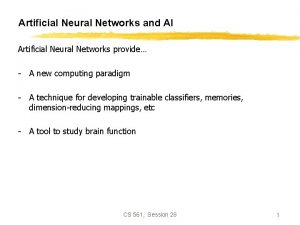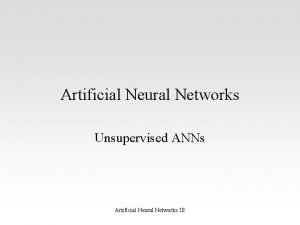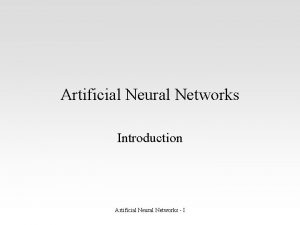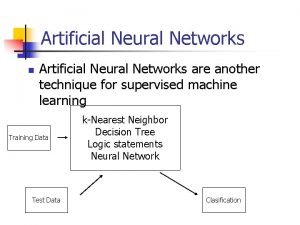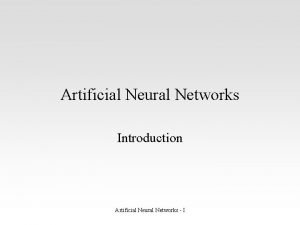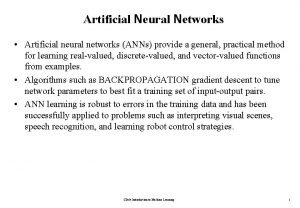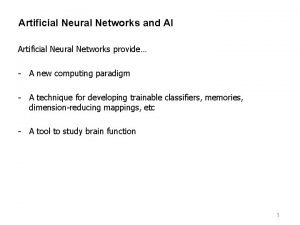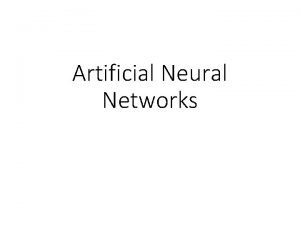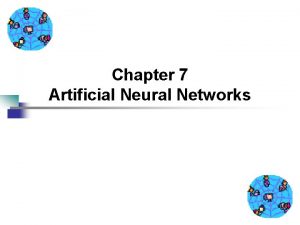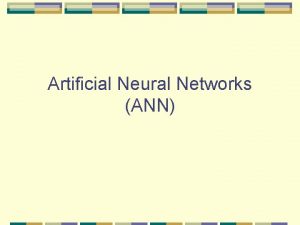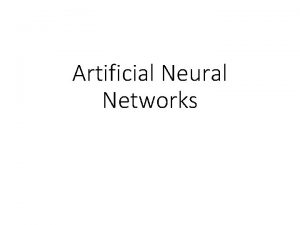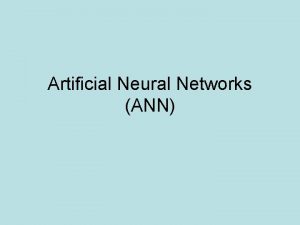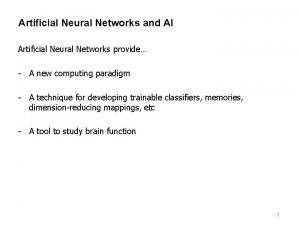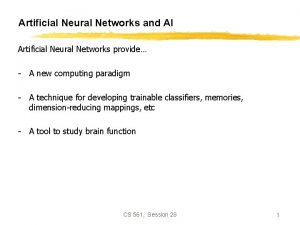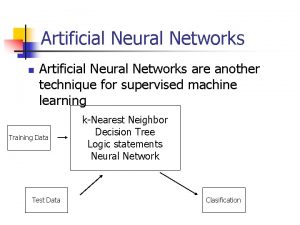Neural Networks References Artificial Intelligence for Games Artificial




























- Slides: 28

Neural Networks References: • “Artificial Intelligence for Games” • "Artificial Intelligence: A new Synthesis"

History • In the 70’s it was *THE* approach to AI – Since then, not so much. • Although it has crept back into some apps. – It still has it’s uses. • Many different types of Neural Nets – (Multi-layer) Feed-forward (perceptron) – Hebbian – Recurrent

Overview • Givens: – A set of n training cases (each represented by a m-bit “binary string”) – The “correct” p-bit answer for each training case. • Supervised vs. Unsupervised • Process: – Train a neural network to “learn” the training cases. • Using the Neural Network. – When exposed to new (grey) inputs, it should pick the closest match. • Better than decision trees in this respect. • Basically: a classifier.

Example Application #1 • Modeling a enemy AI. • The AI can do one of these 4 actions: – – Go for cover Shoot nearest enemy Run away Idle • Training cases: – 50 sample play-throughs, 40 samples (2000 cases) with: • position of player (16 bits) • health of player (6 bits) • ammo-state of player (8 bits) – One of the following: • Supervised training: The action the AI *should* have taken. • Unsupervised training: A way to measure success (based on player/AI state)

Example Application #2 • Training Cases: – 8 8 x 8 pixel images (black/white) (64 bits each) – For each a classification number (3 bits each) • This is supervised learning. • Use: – After training, feed it some images similar to one of the training cases (but not the same) – It *should* return the best classification number.

Perceptrons • Modeled after a single neuron. • Components: – Dendrites (Input) – Axon (Output) – Soma (Activation Function)

Part I: Perceptrons

Perceptron Activation functions •

• 1. 2 1 0. 8 0. 6 0. 4 0. 2 0 0 0. 06 0. 12 0. 18 0. 24 0. 36 0. 42 0. 48 0. 54 0. 66 0. 72 0. 78 0. 840000. . . 0. 900000. . . 0. 960000. . . Perceptron Activation functions, cont. To convert the output of the sigmoid to a "crisp" value (when this is an output from the nnet), you count a value >= 0. 5 as 1.

Perceptron Activation functions, cont. •

Examples • O 0 Perceptron w 0 I 0 w 1 I 1 w 2=-δ 1. 0

Why not XOR? • The first two examples are linearly separable W 2=δ OUTPUT=1 OUTPUT=0 In higher dimensions, the “dividing line” is a hyper-plane, not a plane.

AND and OR δ=0. 75 δ=0. 4 AND OR

XOR You can’t draw a line to separate the “True”’s from the “False”’s

Multi-layer perceptron networks • We can’t solve XOR with one perceptron, but we can solve it with 3. – The 0 th one in the first layer looks for [0, 1] – The 1 st one in the first layer looks for [1, 0] – The only one in the second layer OR’s the output of the first layer’s perceptrons. 0. 2 0. 3

h I j Wjih 0 0 0 -0. 5 0 0 1 0. 4 0 1 0 0. 5 0 1 1 -0. 6 0 2 0 -0. 2 0 2 1 -0. 3 1 0 0 0. 5 1 2 0 -0. 4 XOR NNet O 0 Perceptron 10 W 001 W 021 W 011 Perceptron 00 1. 0 Perceptron 01 W 120 W 000 I 0 W 100 W 110 W 020 W 010 I 1 Notation: Wijh = Weight to layer h, from input#j to perceptron#i 1. 0

Weight matrices + Feed-Forward •

• Feed Forward Example

Feed Forward Example, cont. •

Part II: Training

Training intro •

Training intro, cont. 1. 2 1 0. 8 0. 6 f f(1 -f) 0. 4 0. 2 0. 0 05 5 0. 11 0. 16 5 0. 2 27 5 0. 33 0. 38 5 0. 44 0. 49 5 0. 55 0. 60 5 0. 6 71 5 0. 77 0. 82 5 0. 88 0. 93 5 0. 99 0 • Observations: – If d == o, no change in W – d – o could be -1 or +1. • -1 means the output was too high. Decreases weight • +1 means the output was too low. Increase weight. – The f’ term indicates how “changeable” the value is • f’ of 0 (when f is nearly 1 or nearly 0) means it’s “locked-in” • f’ of 0. 25 (when f is near 0. 5) means it’s very changeable.

Training example • Single perceptron. 2 inputs, one output. – Weights initially [0. 3, 0. 7, 0. 0] • Scenario#1 In=[0, 1, 1]. Desired. Output=0 Feed forward. f(0. 7)=0. 668. f’(0. 7)=0. 224. Err=-0. 668 W += 0. 1 * (0 – 0. 668) * 0. 224 * [0, 1, 1] W is now [0. 3, 0. 685, -0. 015] Feed forward. f(0. 685)=0. 664. f'(0. 685)=0. 223. Err=-0. 661 If we repeat this 299 more times: Err=-0. 032 • Scenario#2 In=[0, 1, 1]. Desired. Output=1 Feed forward. f(0. 7)=0. 668. f'(0. 7)=0. 224. Err=0. 332 W += 0. 1 * (1 – 0. 668) * 0. 224 * [0, 1, 1] W is now [0. 3, 0. 707, 0. 007] Feed forward. f(0. 715)=0. 671. f'(0. 715)=0. 22. Err=0. 329 If we repeat this 299 more times: Err=0. 055

Training example, cont. • Basically, we're… – Adjusting weights: • We subtract from the weight if the error is negative and we have a 1 for input – Negative Error == output is too high. • We add to the weight if the error is positive and we have a 1 for input. – Positive Error == output is too low. • If the input is 0, leave weight unchanged. – The threshold (δ) is a weight too, where the input is always 1. • So even if the inputs are all 0, we could still change threshold.

Training intro, cont. • You repeatedly show examples, I – Perhaps in a random order • Weight values will stabilize at “correct” values. – *IF* the answers are linearly separable (like AND; unlike XOR) – If they aren’t it, will at least minimize the error.

Training Hidden Layers • A bit more complex… • The last weight matrix ("below" the output) is trained just as with a single perceptron – Treat the rows as the weight vectors. – The error is the difference between the desired output and actual output (not "crispified") – Row i in the weight matrix is considered the weight vector • For other matrices – The error is the error from the layer above weighted proportional to the (current) weight values feeding into that layer. • Assigning blame

Training Hidden Layers • Updating Wi: If i is the last (top) matrix: Else: W • Updating weights feeding into a hidden perceptron: – Divide up the error of perceptrons this one feeds into (assigning blame) – wk is the weight from the node we're feeding into to the kth node in the next layer up. – errk is the error of the kth node in the next layer up.

Training Hidden Layer example P 2, 0 Err 0 = d 0 – o 0 P 2, 1 Err 1 = d 1 – o 1 P 1, 0 P 1, 1 P 1, 2 HErr 1, 0=Err • W 2 col(0) HErr 1, 1=Err • W 2 col(1) HErr 1, 2=Err • W 2 col(2) 1. 0 P 0, 1 P 0, 2 P 0, 2 P 0, 3 HErr 0, 0=HErr 1 • HErr 0, 1=HErr 1 • HErr 0, 2=HErr 1 • HErr 0, 3=HErr 1 • W 1 col(0) W 1 col(1) W 1 col(2) W 1 col(3) I 0 I 1 I 2 1. 0
 References for artificial intelligence
References for artificial intelligence Predicting nba games using neural networks
Predicting nba games using neural networks Optimal decisions in games in artificial intelligence
Optimal decisions in games in artificial intelligence Optimal decisions in games in artificial intelligence
Optimal decisions in games in artificial intelligence Input layer
Input layer Least mean square algorithm in neural network
Least mean square algorithm in neural network Few shot learning with graph neural networks
Few shot learning with graph neural networks Neural pruning ib psychology
Neural pruning ib psychology Neural networks simon haykin
Neural networks simon haykin Nvdla
Nvdla Audio super resolution using neural networks
Audio super resolution using neural networks Rnn
Rnn Fuzzy logic lecture
Fuzzy logic lecture Newff matlab
Newff matlab Lstm components
Lstm components Deep forest towards an alternative to deep neural networks
Deep forest towards an alternative to deep neural networks Audio super resolution using neural networks
Audio super resolution using neural networks Csrmm
Csrmm Deep neural networks and mixed integer linear optimization
Deep neural networks and mixed integer linear optimization Convolutional neural network alternatives
Convolutional neural network alternatives Visualizing and understanding convolutional networks
Visualizing and understanding convolutional networks Introduction to convolutional neural networks
Introduction to convolutional neural networks Neural networks for rf and microwave design
Neural networks for rf and microwave design Convolutional neural networks
Convolutional neural networks Convolutional neural networks for visual recognition
Convolutional neural networks for visual recognition Neural networks and learning machines
Neural networks and learning machines On the computational efficiency of training neural networks
On the computational efficiency of training neural networks Convolutional neural network
Convolutional neural network Convolutional neural networks
Convolutional neural networks


